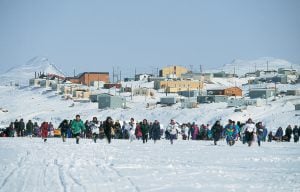Today, the native populations of Canada’s Eastern Arctic and Greenland are known as the Inuit. In the past, explorers and anthropologists referred to them by one broad term: Eskimo (originally used by non-Inuit to refer to native populations in a derogatory way).
When J. Lewis Robertson, a geographer and professor at the University of British Columbia, wrote in a September 1944 feature article for the Canadian Geographical Journal that the “Canadian Eskimo population is not a homogenous people ” the term was still acceptable. The 15-page piece outlines the demographics of the Inuit population in the eastern Arctic, describing the seasonal camps of Inuit communities and some features that differentiate them from populations in the western Arctic. The article’s purpose is to highlight the difficulties in “administering” this region due to its geography and its related demographics. The accompanying map shows the distribution of Inuit settlements in the east, identifying seasonal camps (including “usual” and “occasional” summer and winter camps), and unoccupied posts and “white” settlements. It encompasses the districts of Mackenzie and Keewatin to the west, Ellesmere Island and Greenland to the north and Nunavik to the east.
Robinson’s article makes the point that, “ This regional survey…illustrates that they are not evenly distributed throughout the Eastern Arctic, and thus any planning for the future and welfare of the Eskimo [sic] will have to consider areas of greatest density.”
In 1944, the American Military reported the appalling living conditions for the Inuit, and numerous American newspapers reported on these findings, including the lack of education and rampant illness. In light of these reports, as well as others, The Canadian Social services Board, with the help of Dr. Andrew Moore and Dr. G. J. Wherrett, conducted a study of education among this population. They found that up to 75 percent of native northerners lacked any formal education, and there were high rates of infant deaths and epidemics.
Robinson’s article goes on the say that, “Their seasonal hunting and trapping activities… make them a difficult people to whom to bring education and medical attention.” At the end of the article are a number of graphs comparing the Inuit population with that of southern provinces. The infant death rate was more than twice that of the national average.
The same year this article was published, the government introduced the Family Allowance Program, providing the Inuit with a source of income for each child. However, they were persuaded to buy southern products to stave off starvation and in later years, the government threatened to take away this allowance if they did not send their children to residential schools. In 1947, the federal government took over northern education and introduced the mission system, without any attempt to assess how this would affect the Inuit people.
– With files from canadiangeographic.ca/youarehere





